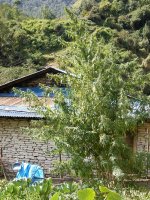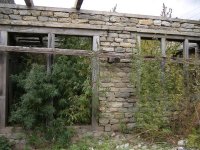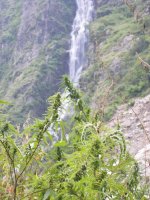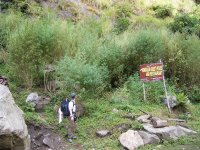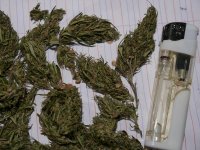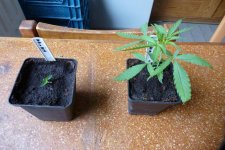PURE SATIVA FROM THE ANNAPURNA MOUNTAINSIDE, USED TO PRODUCE THE FAMOUS NEPALESE CHARAS
Pure sativa landrace from the slopes of Annapurna at more than 2000 metres altitude, which produces a classic and authentic wild Nepalese sativa phenotype: tall and lanky sativas with sticky, slender and flexible stems, which thrive in poor soils with very little cares and attentions, showing excellent resistance against mould, rain, wind, cold and strong temperature contrasts.
Its delicate and spongy flowers with small floral bracts and long pistils mature in moderate flowering times for a pure sativa (12-14 weeks), and acquire beautiful purple and pink colours at the end of flowering in low temperatures.
The locals rub their flowers with their bare hands from the second half of flowering onwards, so the hands get impregnated with resins, from which the famous Nepalese charas is produced: hashish of spicy and incensey aromas, sometimes slightly mentholated and fruity, which delivers a clean, refreshing, inspiring and spiritual effect that elevates the mind to the highest peaks of consciousness, and that for the quality of its effects and terpenes is considered as one of the best and finest hashishes in the cannabis world.
AVAILABLE IN STANDARD FORMAT
P2 LANDRACE STRAIN
100 % SATIVA
FLOWERING INDOORS: 12-14 WEEKS
FLOWERING OUTDOORS: END OF OCTOBER / EARLY NOVEMBER
YIELD / M2: AVERAGE
RESISTANCE AGAINST SPIDER MITES: AVERAGE -HIGH
RESISTANCE AGAINST MILDEW: HIGH
RESISTANCE AGAINST BOTRYTIS: VERY HIGH
RESISTANCE AGAINST WHITE FLY: AVERAGE -HIGH
RESISTANCE AGAINST COLD: VERY HIGH
RESISTANCE AGAINST HEAT: HIGH
LATITUDE: 0º-45º
THC: 5-9 %
CBD: 0.5 %
CBG: 0.5 %
Terpene profile: It has not yet been analyzed.
GENETICS: 2nd generation Nepalese pure sativa.
STRUCTURE: Tall, elegant and flexible sativa structure, thin stems, long internode length and lanky branching.
BOUQUET: Spicy, woody, mountain aromatic herbs, hashish, incense, sometimes fruity (strawberry, lemon, watermelon) and with hints of eucalyptus and mint.
HIGH: Mild psychoactivity of moderate duration, with excellent sativa qualities: clean, balanced, refreshing, inspiring and spiritual, not at all aggressive, and without producing tiredness, lethargy or other undesired side effects.
CULTIVATION TIPS
It can be grown indoors with enough space for its development. We recommend to switch her into flowering after 15 days from seed, or starting from clones rooted for at least 7 days.
Very suitable for SCROG, horizontal or network growing due to its excellent yield in the lateral branches and its vigorous reaction to pruning.
Outdoors it can be grown up to latitude 45º, both in hot climates and in climates where the flowering takes place with rain and low temperatures. Excellent resistance against botrytis fungi, rain, wind, cold and strong thermal contrasts.
We recommend low-moderate levels of nutrients for the growing stage, moderate of PK at the peak of floral production in mid-flowering.
Pure sativa landrace from the slopes of Annapurna at more than 2000 metres altitude, which produces a classic and authentic wild Nepalese sativa phenotype: tall and lanky sativas with sticky, slender and flexible stems, which thrive in poor soils with very little cares and attentions, showing excellent resistance against mould, rain, wind, cold and strong temperature contrasts.
Its delicate and spongy flowers with small floral bracts and long pistils mature in moderate flowering times for a pure sativa (12-14 weeks), and acquire beautiful purple and pink colours at the end of flowering in low temperatures.
The locals rub their flowers with their bare hands from the second half of flowering onwards, so the hands get impregnated with resins, from which the famous Nepalese charas is produced: hashish of spicy and incensey aromas, sometimes slightly mentholated and fruity, which delivers a clean, refreshing, inspiring and spiritual effect that elevates the mind to the highest peaks of consciousness, and that for the quality of its effects and terpenes is considered as one of the best and finest hashishes in the cannabis world.
AVAILABLE IN STANDARD FORMAT
P2 LANDRACE STRAIN
100 % SATIVA
FLOWERING INDOORS: 12-14 WEEKS
FLOWERING OUTDOORS: END OF OCTOBER / EARLY NOVEMBER
YIELD / M2: AVERAGE
RESISTANCE AGAINST SPIDER MITES: AVERAGE -HIGH
RESISTANCE AGAINST MILDEW: HIGH
RESISTANCE AGAINST BOTRYTIS: VERY HIGH
RESISTANCE AGAINST WHITE FLY: AVERAGE -HIGH
RESISTANCE AGAINST COLD: VERY HIGH
RESISTANCE AGAINST HEAT: HIGH
LATITUDE: 0º-45º
THC: 5-9 %
CBD: 0.5 %
CBG: 0.5 %
Terpene profile: It has not yet been analyzed.
GENETICS: 2nd generation Nepalese pure sativa.
STRUCTURE: Tall, elegant and flexible sativa structure, thin stems, long internode length and lanky branching.
BOUQUET: Spicy, woody, mountain aromatic herbs, hashish, incense, sometimes fruity (strawberry, lemon, watermelon) and with hints of eucalyptus and mint.
HIGH: Mild psychoactivity of moderate duration, with excellent sativa qualities: clean, balanced, refreshing, inspiring and spiritual, not at all aggressive, and without producing tiredness, lethargy or other undesired side effects.
CULTIVATION TIPS
It can be grown indoors with enough space for its development. We recommend to switch her into flowering after 15 days from seed, or starting from clones rooted for at least 7 days.
Very suitable for SCROG, horizontal or network growing due to its excellent yield in the lateral branches and its vigorous reaction to pruning.
Outdoors it can be grown up to latitude 45º, both in hot climates and in climates where the flowering takes place with rain and low temperatures. Excellent resistance against botrytis fungi, rain, wind, cold and strong thermal contrasts.
We recommend low-moderate levels of nutrients for the growing stage, moderate of PK at the peak of floral production in mid-flowering.

